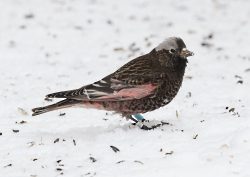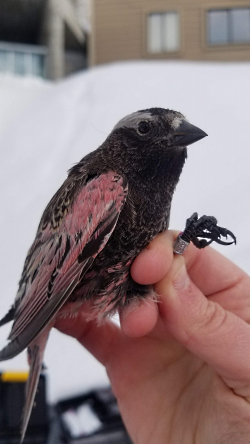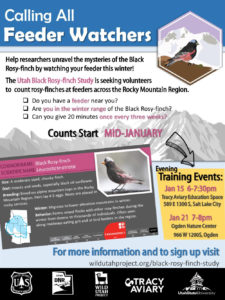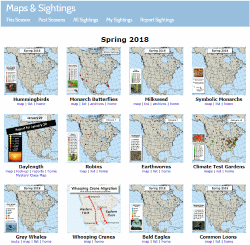
Courtesy & © Shannon Rhodes, Photographer
 Glovers Silk Moth
Glovers Silk Moth
Courtesy & © Shannon Rhodes, PhotographerThis week I couldn’t make time to get out into nature, so nature came to me. I suppose people think that once students stack chairs and say goodbye as they carry their yearbooks, portfolios, and report cards out the door, their teacher lounges all summer in a hammock with a just-for-fun book and a lemonade. Perhaps a few teachers do. This teacher was scurrying off to afternoon meetings about math tutoring and curriculum planning after spending mornings discussing hundreds of scholarly journal pages she’d read the night before about effective writing instruction. No, I wouldn’t make time this week for nature, so nature came to me, begging me to slow down, take notice, pause, breathe.
First, it was a bird with a yellow head perched just outside my bedroom window as I hit the alarm. I didn’t take the time to get the details or even listen to its song as I rushed off to the car. Was it a warbler or a meadowlark? I’m not sharp enough on my bird identifying yet to instantly know, and there was no time anyway. Not even to take a picture.
Rushing from my office to the adjacent building for class, I did stop to stare at the largest moth I’d ever seen that was perched on the similarly-colored rusty-brown brick. This time I pulled out my phone to get some shots, certain that the iNaturalist app would reveal how uncommon it is to see a moth bigger than the size of my fist leisurely greeting me on the summer camp-bustling university campus. Patiently it sat as I zoomed in closer to get all the angles of its head, wooly abdomen, and wing patterns. 7:58–time to go find my seat.
Later, my iNaturalist app provided a suggestion: Glover’s Silk Moth, a rather common find this time of year in my part of the world. Then, as I sat on a dining patio overlooking the river telling my friends about the moth, a garter snake skirted the rock wall just feet away from me until it found a comfortable spot to watch and listen.
Suddenly, I realized that nature was hosting a BioBlitz for me if I wanted to join in. A BioBlitz, according to the partnership of National Geographic and iNaturalist, is “a celebration of biodiversity….focused on finding and identifying as many species as possible in a specific area over a short period of time.” Children’s book author Loree Griffin Burns cleverly guides her young readers in similarly throwing a Moth Ball.
Last June I learned that my tangerine-colored moth find in Logan Canyon was a Nuttall’s Sheep Moth, and that I could join citizen scientists all over in pinning observations on the map and logging wild encounters like this new-to-me species, especially during National Moth Week. It was William Wordsworth who wisely wrote, “Come forth into the light of things, Let Nature be your teacher.” This week she was trying to teach me to be more aware, that my day’s list could allow time to appreciate a yellow bird, a curious snake, and a marvelous giant silk moth, and suddenly I was also spotting ladybug larva and ring-necked pheasants. I had time. As Richard Louv states in his book titled Last Child in the Woods, “Nature does not steal time; it amplifies it.”
For Wild About Utah, I’m Shannon Rhodes.
Credits:
Images: Courtesy & Copyright Shannon Rhodes, Photographer
Additional Audio: Courtesy & © Kevin Colver https://wildstore.wildsanctuary.com/collections/special-collections
Text: Shannon Rhodes, Edith Bowen Laboratory School, Utah State University https://edithbowen.usu.edu/
Additional Reading Links: Shannon Rhodes
Additional Reading:
Burns, Loree Griffin. You’re Invited to a Moth Ball: A Nighttime Insect Celebration. 2020. https://loreeburns.com/
Greene, Jack. Join a BioBlitz This Year. Wild About Utah, May 30, 2016. https://wildaboututah.org/bioblitz/
Insect Identification.org. Glover’s Silkmoth. January 3, 2022. https://www.insectidentification.org/insect-description.php?identification=Glovers-Silkmoth
Louv, Richard. Last Child in the Woods: Saving Our Children from Nature-Deficit Disorder. 2008. https://richardlouv.com/books/last-child
National Geographic. BioBlitz. https://www.nationalgeographic.org/projects/bioblitz/
National Moth Week, Friends of the East Brunswick Environmental Commission, https://nationalmothweek.org/
Rhodes, Shannon. Malacomosa Dance. Wild About Utah, June 21, 2021. https://wildaboututah.org/malacomosa-dance/
University of Wisconsin Milwaukee Field Station. Giant Silk Moths. November 26, 2014. https://uwm.edu/field-station/giant-silk-moths-family-saturnidae/
Winter, William D. Jr. Basic Techniques for Observing and Studying Moths & Butterflies. The Lepidopterists’ Society. 2000. https://www.lepsoc.org/sites/all/themes/nevia/lepsoc/Memoir_5_Basic_techniques_manual.pdf
Wordsworth, William. The Tables Turned. 1798. https://www.poetryfoundation.org/poems/45557/the-tables-turned






